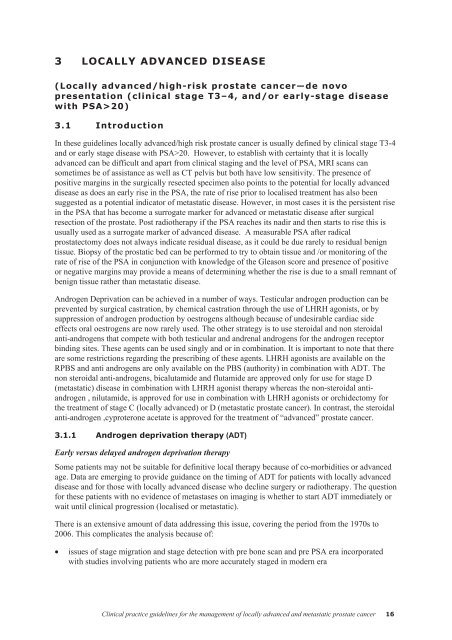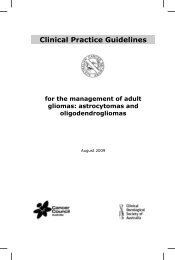Clinical Practice Guidelines for the management of locally advanced ...
Clinical Practice Guidelines for the management of locally advanced ...
Clinical Practice Guidelines for the management of locally advanced ...
Create successful ePaper yourself
Turn your PDF publications into a flip-book with our unique Google optimized e-Paper software.
3 LOCALLY ADVANCED DISEASE<br />
(Locally <strong>advanced</strong>/high-risk prostate cancer—de novo<br />
presentation (clinical stage T3–4, and/or early-stage disease<br />
with PSA>20)<br />
3.1 Introduction<br />
In <strong>the</strong>se guidelines <strong>locally</strong> <strong>advanced</strong>/high risk prostate cancer is usually defined by clinical stage T3-4<br />
and or early stage disease with PSA>20. However, to establish with certainty that it is <strong>locally</strong><br />
<strong>advanced</strong> can be difficult and apart from clinical staging and <strong>the</strong> level <strong>of</strong> PSA, MRI scans can<br />
sometimes be <strong>of</strong> assistance as well as CT pelvis but both have low sensitivity. The presence <strong>of</strong><br />
positive margins in <strong>the</strong> surgically resected specimen also points to <strong>the</strong> potential <strong>for</strong> <strong>locally</strong> <strong>advanced</strong><br />
disease as does an early rise in <strong>the</strong> PSA, <strong>the</strong> rate <strong>of</strong> rise prior to localised treatment has also been<br />
suggested as a potential indicator <strong>of</strong> metastatic disease. However, in most cases it is <strong>the</strong> persistent rise<br />
in <strong>the</strong> PSA that has become a surrogate marker <strong>for</strong> <strong>advanced</strong> or metastatic disease after surgical<br />
resection <strong>of</strong> <strong>the</strong> prostate. Post radio<strong>the</strong>rapy if <strong>the</strong> PSA reaches its nadir and <strong>the</strong>n starts to rise this is<br />
usually used as a surrogate marker <strong>of</strong> <strong>advanced</strong> disease. A measurable PSA after radical<br />
prostatectomy does not always indicate residual disease, as it could be due rarely to residual benign<br />
tissue. Biopsy <strong>of</strong> <strong>the</strong> prostatic bed can be per<strong>for</strong>med to try to obtain tissue and /or monitoring <strong>of</strong> <strong>the</strong><br />
rate <strong>of</strong> rise <strong>of</strong> <strong>the</strong> PSA in conjunction with knowledge <strong>of</strong> <strong>the</strong> Gleason score and presence <strong>of</strong> positive<br />
or negative margins may provide a means <strong>of</strong> determining whe<strong>the</strong>r <strong>the</strong> rise is due to a small remnant <strong>of</strong><br />
benign tissue ra<strong>the</strong>r than metastatic disease.<br />
Androgen Deprivation can be achieved in a number <strong>of</strong> ways. Testicular androgen production can be<br />
prevented by surgical castration, by chemical castration through <strong>the</strong> use <strong>of</strong> LHRH agonists, or by<br />
suppression <strong>of</strong> androgen production by oestrogens although because <strong>of</strong> undesirable cardiac side<br />
effects oral oestrogens are now rarely used. The o<strong>the</strong>r strategy is to use steroidal and non steroidal<br />
anti-androgens that compete with both testicular and andrenal androgens <strong>for</strong> <strong>the</strong> androgen receptor<br />
binding sites. These agents can be used singly and or in combination. It is important to note that <strong>the</strong>re<br />
are some restrictions regarding <strong>the</strong> prescribing <strong>of</strong> <strong>the</strong>se agents. LHRH agonists are available on <strong>the</strong><br />
RPBS and anti androgens are only available on <strong>the</strong> PBS (authority) in combination with ADT. The<br />
non steroidal anti-androgens, bicalutamide and flutamide are approved only <strong>for</strong> use <strong>for</strong> stage D<br />
(metastatic) disease in combination with LHRH agonist <strong>the</strong>rapy whereas <strong>the</strong> non-steroidal antiandrogen<br />
, nilutamide, is approved <strong>for</strong> use in combination with LHRH agonists or orchidectomy <strong>for</strong><br />
<strong>the</strong> treatment <strong>of</strong> stage C (<strong>locally</strong> <strong>advanced</strong>) or D (metastatic prostate cancer). In contrast, <strong>the</strong> steroidal<br />
anti-androgen ,cyproterone acetate is approved <strong>for</strong> <strong>the</strong> treatment <strong>of</strong> “<strong>advanced</strong>” prostate cancer.<br />
3.1.1 Androgen deprivation <strong>the</strong>rapy (ADT)<br />
Early versus delayed androgen deprivation <strong>the</strong>rapy<br />
Some patients may not be suitable <strong>for</strong> definitive local <strong>the</strong>rapy because <strong>of</strong> co-morbidities or <strong>advanced</strong><br />
age. Data are emerging to provide guidance on <strong>the</strong> timing <strong>of</strong> ADT <strong>for</strong> patients with <strong>locally</strong> <strong>advanced</strong><br />
disease and <strong>for</strong> those with <strong>locally</strong> <strong>advanced</strong> disease who decline surgery or radio<strong>the</strong>rapy. The question<br />
<strong>for</strong> <strong>the</strong>se patients with no evidence <strong>of</strong> metastases on imaging is whe<strong>the</strong>r to start ADT immediately or<br />
wait until clinical progression (localised or metastatic).<br />
There is an extensive amount <strong>of</strong> data addressing this issue, covering <strong>the</strong> period from <strong>the</strong> 1970s to<br />
2006. This complicates <strong>the</strong> analysis because <strong>of</strong>:<br />
issues <strong>of</strong> stage migration and stage detection with pre bone scan and pre PSA era incorporated<br />
with studies involving patients who are more accurately staged in modern era<br />
<strong>Clinical</strong> practice guidelines <strong>for</strong> <strong>the</strong> <strong>management</strong> <strong>of</strong> <strong>locally</strong> <strong>advanced</strong> and metastatic prostate cancer<br />
16



